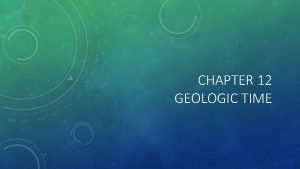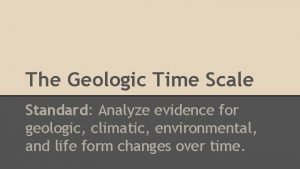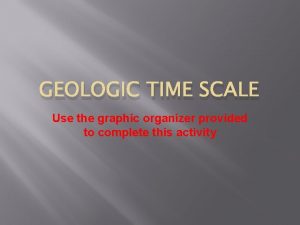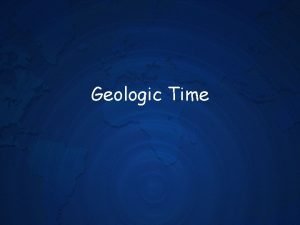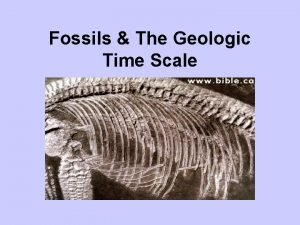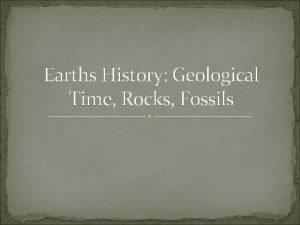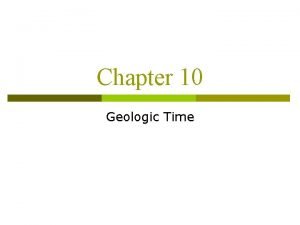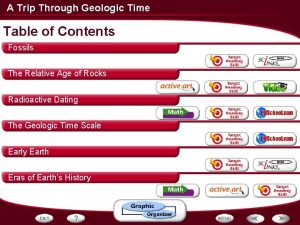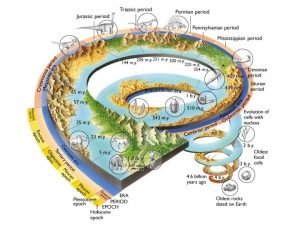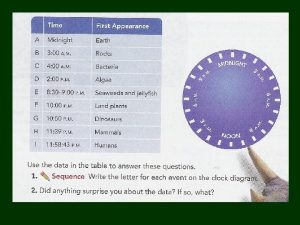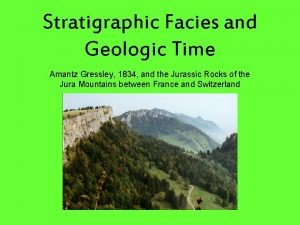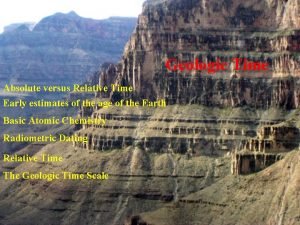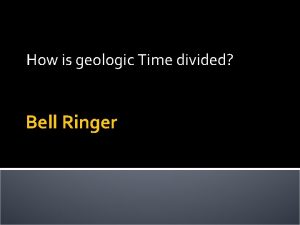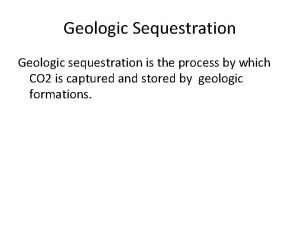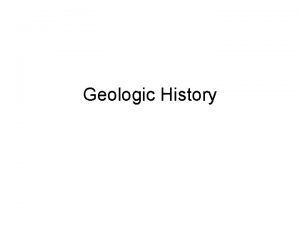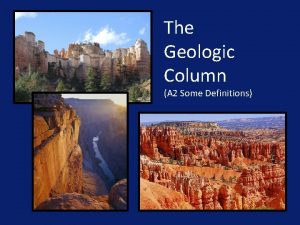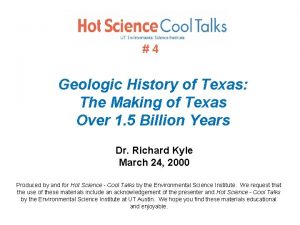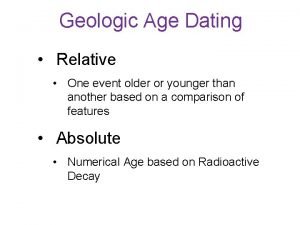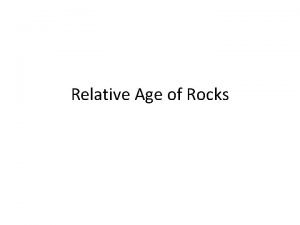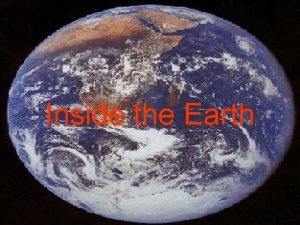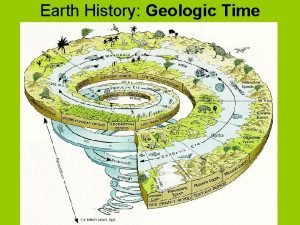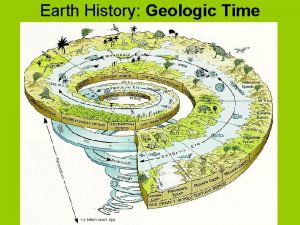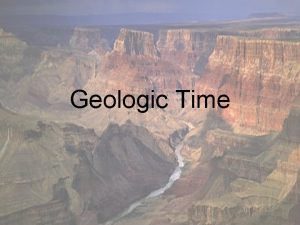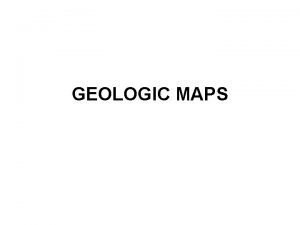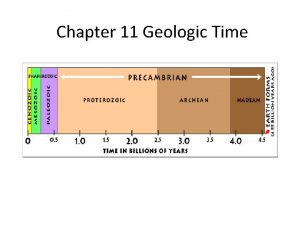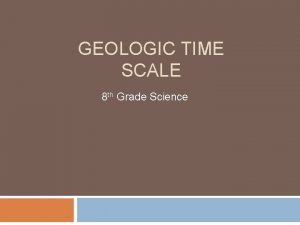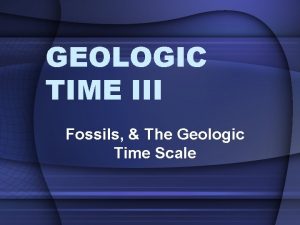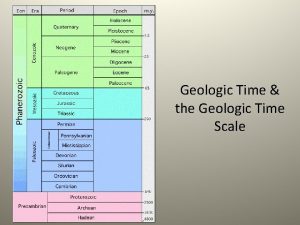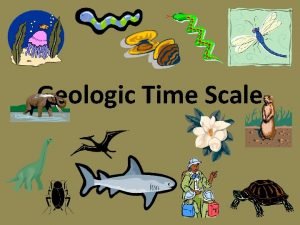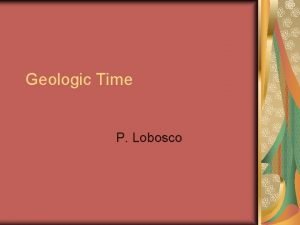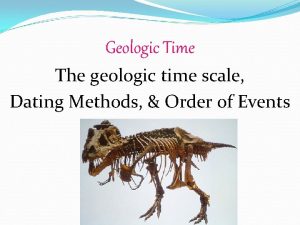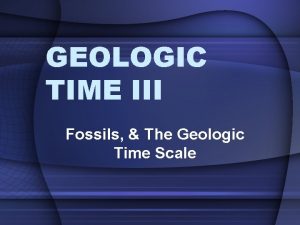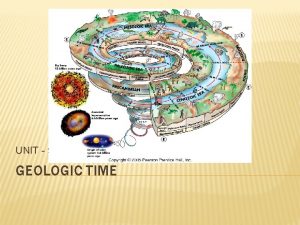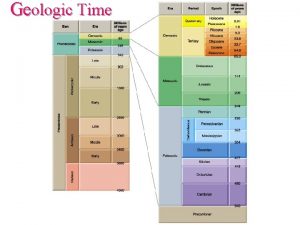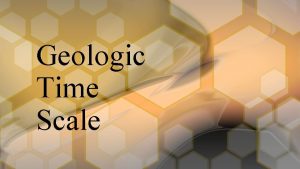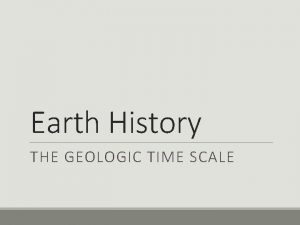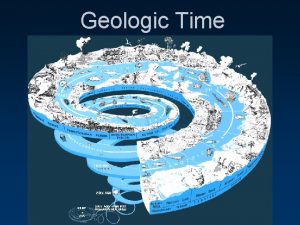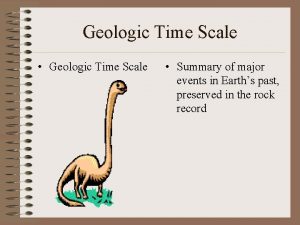Geologic Time Chapter 10 8 th Grade Life








































- Slides: 40

Geologic Time Chapter 10 8 th Grade

Life and Geologic Time Scale: The divisions of earths history.

Life and Geologic Time The break down from large to small: Eon: Based upon the abundance of certain fossils. Era: Marked by major, striking, and worldwide changed in the types of fossils present. Period: characterized by the types of life existing world wide at the time. Epochs: Smaller units of time, differences in life forms but can sometimes only be from continent to continent.

Early Earth History During this section we will study Earths early history during the Precambrian Time & the Paleozoic Era.

Precambrian Time Precambrian time is the longest part of our Earths history including the Hadean, Archean and Proterozoic Eras. 4. 5 billion years ago to about 544 million years ago

Precambrian Time Very little known about the organisms that lived during this time. Most animals during this time didn’t have hard parts For example, Cyanobacteria (Visual), a blue/green algae which produced oxygen and underwent photosynthesis.

Precambrian Time Toward the end of the Precambrian Time, animals without backbones started to appear, Invertebrates. Soft Bodied Not often fossilized, most which were fossilized are considered trace fossils.

Paleozoic Era The abundance of hard parted animals like shells marked the beginning of the Paleozoic Era. 544 million years ago to about 248 million years ago. Many Paleozoic organisms lived in the ocean

Paleozoic Era Vertebrates, or animals with backbones, also evolved during this era. The first, sea creatures without jaws. Other jawed creatures came around the Devonian period. (On land as well!)

Paleozoic Era Life on land!!! (Lung fin fish to Amphibians) Amphibian to Reptile

Paleozoic Era Several mountains began forming during this time including the Appalachian. Lowering sea level and causing climate change. All because of Plate tectonics and Seafloor Spreading!!! This caused 90% of all marine species and 70% of land species to die.

Section 3: Middle and Recent Earth history Section 1 -2 Review: What differences are found among the organisms that lived in the Precambrian time vs. the Paleozoic era?

Middle & Recent Earth During this section we will talk about the remaining portions of our geologic time scale including the Mesozoic Era & the Cenozoic Era.

Bell work What ended the Precambrian time? What ended the Paleozoic Era?

Mesozoic Era Dinosaurs! Dinosaurs have captured the interest of humans for over 100 Years. These organisms lived during this Mesozoic Era. 248 million years ago to about 65 million years ago.

Mesozoic Era The breakup of Pangaea! During the Triassic Period: It continued to separate over Earths time and eventually formed the continents we see on earth now.

Mesozoic Era Dinosaurs ranged from 1 mm tall to huge animals like Apatosaurus and Tyrannosaurus. The first small dinosaurs lived during the Triassic and evolved into larger species during the Jurassic and Cretaceous Periods.

Mesozoic Era Dinosaurs were active! Fossil records allowed scientists to calculate how fast they ran (Gallimimus reaching up to 65 km—as fast as a modern racehorse). May have been more fast moving and warm blooded like present day mammals and birds rather than cold blooded reptile like animals.

Mesozoic Era May have been more fast moving and warm blooded like present day mammals and birds rather than cold blooded reptile like animals.

Mesozoic Era Fossil records also suggest that some dinosaurs may have nurtured and cared for their young. Maiasaura Build nests Raised offspring in close clusters.

Mesozoic Era Birds first appeared during the Jurassic Period. Archaeopteryx evolved from the Bambiraptor Feinberger.

Mesozoic Era Mammals first appeared in the Triassic Period. First mammals were small mouse like creatures.

Mesozoic Era Gymnosperms: plants that produced seeds but not flowers dominated the land during the Mesozoic Era. Angiosperms: flowering plants, first appeared in the cretaceous period.

Mesozoic Era ended with a major extinction of land marine animals. Many species, including dinosaurs, disappeared suddenly during this time. Many causes have been hypothesized but none have been proven.

Cenozoic Era of recent life 65 million years ago and continues today. Broken up into two periods: Tertiary and Quaternary Includes massive climate changes like ice ages.

Cenozoic Era Many mountain ranges have formed during this recent Era including the Himalaya Mountains along India and Tibet.

Cenozoic Era Expanding grasslands have favored mammals like deer, horse, camels, and some elephants. Mammals now rule our earth and even live in the sea Whale and dolphin species. Homo Sapiens: Humans Appeared 140, 000 years ago.

Evolution of Primates

Chapter Review/Overview https: //youtu. be/sj. E-Pkjp 3 u 4 Crash course https: //youtu. be/h. SSzn 4 b. Iw. Zg evolutionary process animation

Project Include: Plants Animals Time range Environment/land Pictures/diagrams Words/descriptions TITLE!!!

Making our Timeline Each group will master their time period Precambrian time Paleozoic era Mesozoic era Cenozoic era Group 5 will be making the outline of the entire geologic time scale. Their project will be complete when the rest of the groups insert their poster within the time scale.

Life and Geologic Time Organic Evolution: Fossil records show that species of animals have changed over geologic time. Helps an animal to survive in the changing environment and continue to reproduce.

Life and Geologic Time Natural Selection: organisms who have characteristics that fit the environment have a better chance of surviving. Organisms compete with each other food, water, and shelter. Organisms of the same species could have different characteristics that hurt or help them.

Life and Geologic Time Artificial Selection: Humans use this for breeding animals. They carefully choose desired characteristics. For example, breeding cattle, dogs, cats, chickens, even plants.

Compare and Contrast In your science journal, make a Venn diagram to compare and contrast natural selection vs. artificial selection.

Life and Geologic Time Have you heard of Trilobites? ? They have three lobes and three segments in its body. They existed on earth for over 200 million years because they were great at evolving to fit their environment.

Life and Geologic Time Visuals of Trilobites and their evolution Pages 277 -278

Life and Geologic Time Chapter 10 Section 1 Review Questions # 1 & 5 only

Sec 1: LAB The Beak Adaptation Lab

Announcements Beak Lab due TODAY
 Compare geologic time with the geologic column.
Compare geologic time with the geologic column. Chapter 12 geologic time
Chapter 12 geologic time How is the geologic time scale organized
How is the geologic time scale organized Earth's history and geologic time graphic organizer
Earth's history and geologic time graphic organizer Geologic time calendar
Geologic time calendar Geologic time scale animals
Geologic time scale animals Brainpop geologic time
Brainpop geologic time Geologic time scale drawing
Geologic time scale drawing A trip through geologic time answer key
A trip through geologic time answer key Eon division
Eon division Moth scale
Moth scale Geologic time
Geologic time Time scale
Time scale Geologic time scale
Geologic time scale Geologic time scale poem
Geologic time scale poem Geologic time scale
Geologic time scale What is the longest subdivision in geologic time
What is the longest subdivision in geologic time Geologic time scale drawing
Geologic time scale drawing Caprock
Caprock What
What Geologic column definition
Geologic column definition Geologic history of texas
Geologic history of texas Principle of superposition
Principle of superposition Geologic history
Geologic history What is reletive age
What is reletive age What is earth made out of
What is earth made out of Cal gem
Cal gem Example of elapsed time
Example of elapsed time What are the steps in computing grades
What are the steps in computing grades Cinderella kissed a fella
Cinderella kissed a fella What is the white part of an egg called
What is the white part of an egg called Grades of milk
Grades of milk Grade grade
Grade grade Meta - change morph
Meta - change morph Life orientation grade 8
Life orientation grade 8 Grade 7 term 4 natural science
Grade 7 term 4 natural science Grade 11 life sciences animal nutrition
Grade 11 life sciences animal nutrition In march
In march Life orientation grade 12 democracy and human rights
Life orientation grade 12 democracy and human rights Grade 7 life orientation test
Grade 7 life orientation test Computers part of your life
Computers part of your life

